Summary: Agile software development involves collaboratively working in iterative & transparent development methodologies. It is a path that more and more businesses are trying to adopt. If you’re one of those facing issues in doing so, this article is the right advice for you. We list a few common Agile mistakes and how Net Solutions prevents them.
Every organization has a different take on Agile development methodology. Those who successfully adopt sing praises. Others who try adopting but don’t see benefits call it hype. If you’re one of them, you must pause and reflect because the problem may not be Agile product development but how you approach it.
Most businesses face problems with agile software development because they fall prey to agile pitfalls that hamper their ability to achieve their Agile goals. In this article, we’ll talk about Agile mistakes that you can fix to achieve quick wins and streamline your Agile adoption.
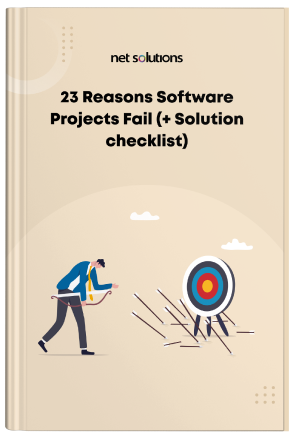
We respect your privacy. Your information is safe.
Top 12 Agile mistakes and How Net Solutions avoids them
1. Poor Agile training during onboarding
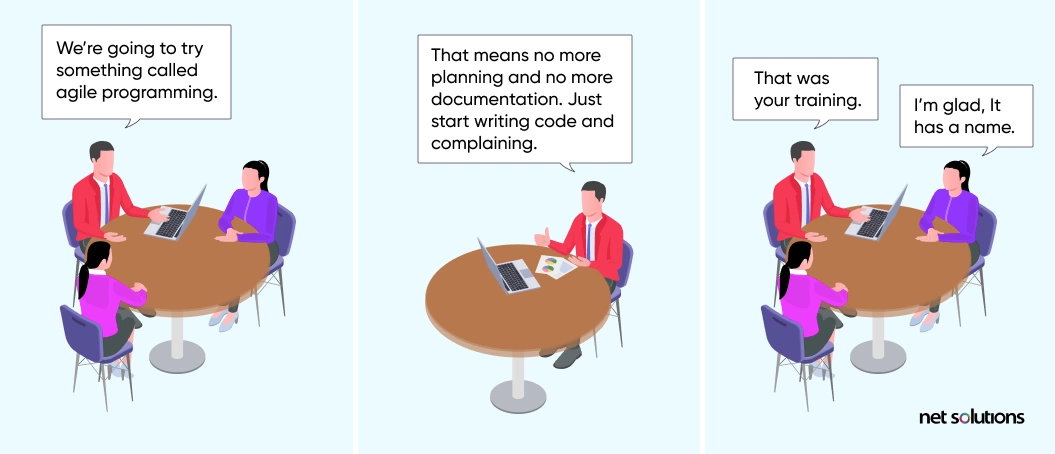
Training is crucial to avoid Agile failure. However, some organizations overlook it. They either skip training or apply it to a few people on a team or project basis.
As a result:
- Teams directly jump into implementing Agile without understanding its why.
- Many organization members miss out on the impact of agile software development.
- New joiners are confused about the organization’s stance and expectations on Agile implementation.
- Teams miss out on deadlines and deliver poor-quality product iterations.
By the time the organization understands what’s happening, it realizes that having untrained or poorly trained teams deliver 3-4 sprints is a lot more costly than the costs of training. That’s why Agile training is crucial.
With our IT team constantly growing, Agile training has become a crucial part of our onboarding process. We ensure that new Agile developers know the expectations and how to manage them efficiently as productive team members before they start working on a project.
For those developers already familiar with Agile in concept, we have found that every company applies Agile in slightly different ways, so retraining keeps everyone on the same page.
At Net Solutions, all employees go through a multi-week onboarding process that:
- introduces them to the Agile philosophy followed by Net Solutions
- provides training on the core tools and systems used in Agile projects
- gives in-depth walkthroughs of processes
- includes an “onboarding buddy” to provide immediate help whenever they have any questions
- facilitates access to senior staff to address concerns
- is driven by a mature process
- is overseen by a dedicated HR Executive.
Since Net Solutions promotes the improvement of processes and inefficiencies, the teams are constantly improving on established practices and procedures and experimenting with tools. Every good enhancement goes through pilot and testing phases before you roll it out to the rest of the organization as part of regular training and refresher sessions.
As an Agile organization, we also leverage Agile training, incorporating feedback to improve project and team performance. Organizational culture plays a crucial role in Agile effectiveness.
2. Not hiring a full-time Scrum Master
The Scrum Master is crucial in keeping an Agile project together and running smoothly. As the conductor of the orchestra at play, the availability and focus of the Scrum Master play a vital role in an Agile project’s success.
Despite this, some organizations are unwilling to hire a skilled Scrum master. They fail to understand the role and find themselves in the following situations:
- Scenario 1: We don’t have a dedicated Scrum master. Do we even need it?
- Scenario 2: Our project manager also handles the responsibilities of a Scrum Master.
- Scenario 3: Our product owner also serves as the Scrum Master.
- Scenario 4: We haven’t hired a Scrum Master yet, and a team member conducts scrum meetings.
None of these approaches is good. Not hiring a dedicated Scrum Master is a critical agile mistake because you won’t be able to do Scrum properly and miss business agility benefits like flexibility, adaptability, short feedback loops, or employee engagement. Hence, you should hire a dedicated Scrum Master who single-mindedly focuses on your project to allow for rapid responses and flexible sprint planning.
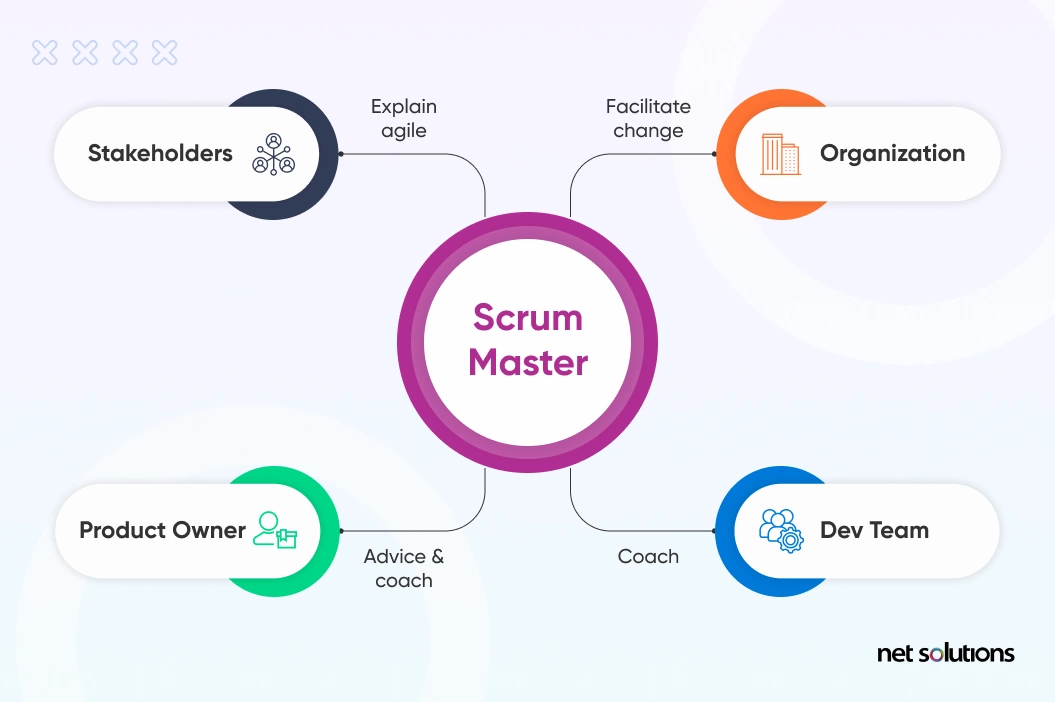
Net Solutions has a dedicated Scrum Master for each project. All of them:
- Have a deep understanding of the project and the team
- Ensure that the team understands the project goals, scope, and processes.
- Support team dynamics
- Are quick to solve impediments
- Focus on the critical aspect of keeping everything running smoothly
These scrum masters focus on the responsibilities involved, not being distracted by additional tasks or alignments with a specific group.
3. Improper sprint planning
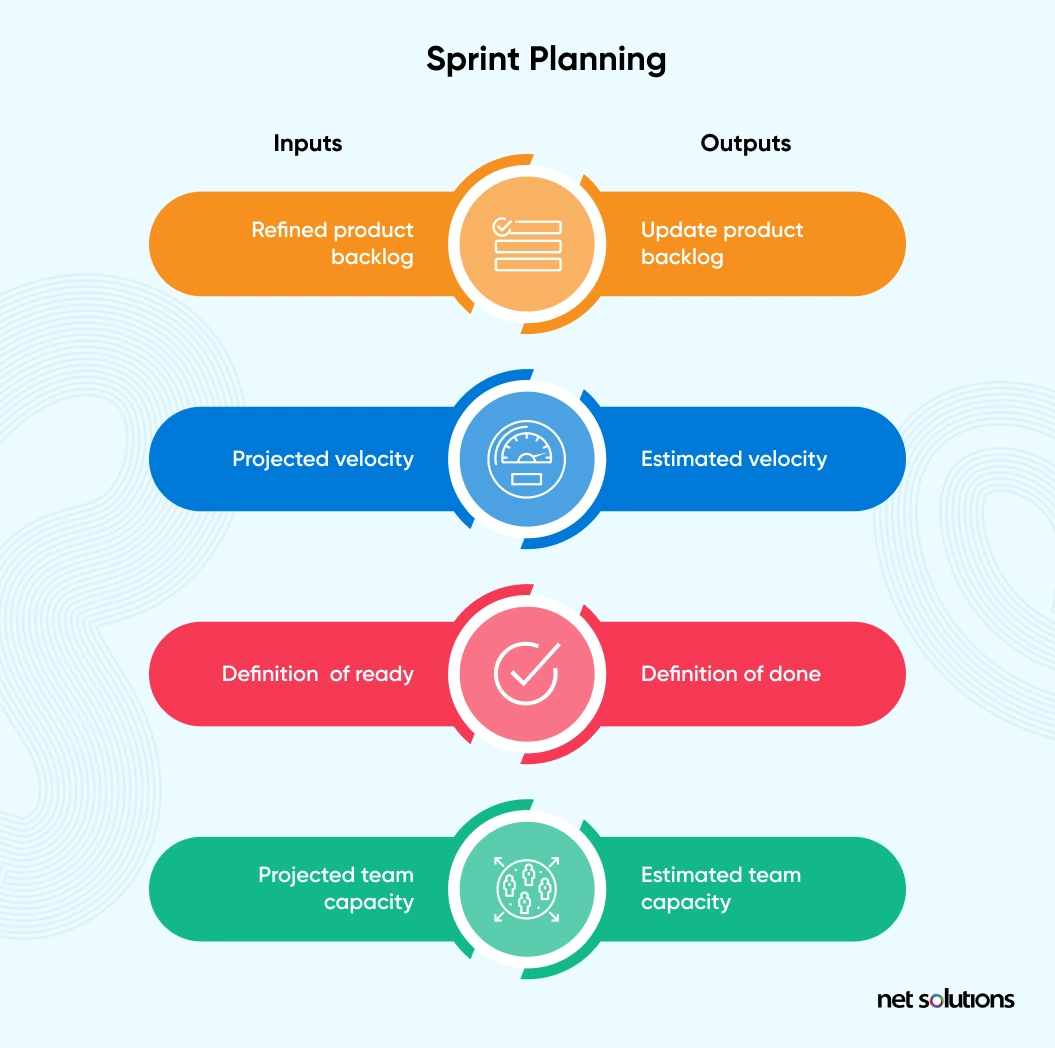
Incorrectly planned sprints can derail your entire project. When you fail to break down the product backlog correctly, developers and the project manager find it challenging to accurately the accurate implementation time. They overcommit, skip deadlines, and the pending items move into a new sprint. Soon it becomes a vicious cycle that takes down the entire project. Hence, it would be best if you planned your sprints properly.
At Net Solutions, we emphasize heavily on sprint planning. We break down each item into minor parts so that each sprint provides practical customer value. It also helps our teams correctly estimate the development time. We also track each sprint with agile metrics like a burn chart to improve planning accuracy and chances of achieving the set goal.
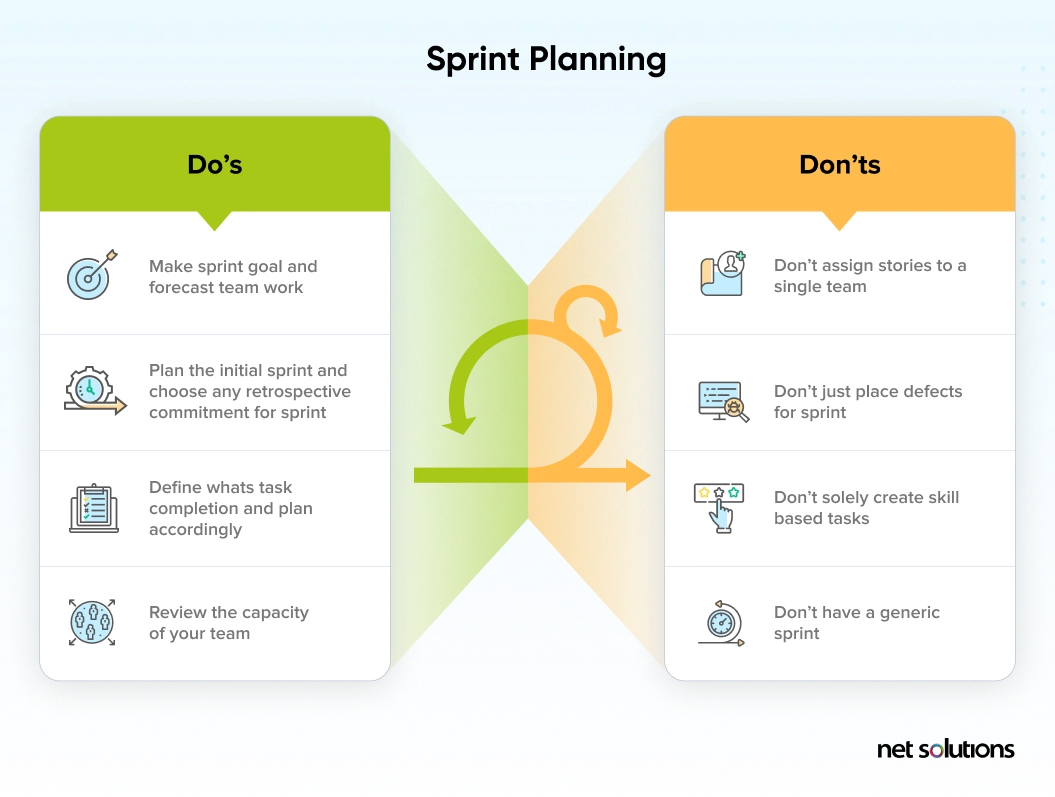
Apart from Sprint planning, we also use various agile estimation techniques to ensure your project never goes off-track and over-budget.
4. Micromanagement instead of delegation
Some organizations claim they use agile project management but micromanage all the activities. They dictate everything the team does, which damages the team morale and prevents the development team from achieving their goals.
Net Solutions focuses on delegation. We make our members capable of working independently and foster an environment where the development team can work without politics or other directions. The approach helps our team achieve goals faster while keeping their morale high.
5. Not having clear milestones
“Agile is not an excuse for chaos or no management.” – Alan Zucker, founding principal of Project Management Essentials.
A misconception is that goal setting is not essential in agile software development, and sometimes this agile mistake becomes the sole reason your entire project goes haywire. Your team falls off track when you don’t have a clear milestone. Team members become confused. They miss deadlines, and your agile development initiative becomes a nightmare.
At Net Solutions, we set clear KPIs and deliverables for all development team members. A project doesn’t kickstart until everyone knows what to deliver and by when. As a result, it becomes easier for teams to manage their workflows and achieve the set goals in a streamlined fashion.
6. Focusing too much on tools
Though there are many good tools for those using Agile development, it can be easy to become myopic and lose focus in the process. JIRA and other popular project management tools can support Agile methodology, helping your team plan, track, and manage your projects. However, these tools are only as good as the team using them.
Net Solutions does not focus on tools at all. For us, they are a means to an end and often change to suit the project or client’s preferences. A tool-agnostic approach to project planning is more in line with Agile methodology:
- The team can opt for a tool specific to a project if they find it a better fit.
- The clients ask for tools they prefer, and we immediately adopt them if they’re suitable for the job.
- When taking over existing projects, if the tools already being used are sufficient, we continue to use them instead of transferring the data to our preferred toolchain.
7. Focusing too much on processes
In the excitement of implementing Agile, organizations can go too far by putting in too many processes, resulting in a less agile framework. As a result, it becomes more about the processes or the tools (as above) and less about the people. In Agile software development, the processes are the “how,” but the core of Agile development is communication and collaboration.
Net Solutions ensures the Agile teams are empowered and encouraged to focus on collaboration and communication. While we follow processes for efficiency, we take care that they do not become bureaucratic bottlenecks. We use a range of formal & informal activities to ensure this is true, including:
- Release planning meetings in which we discuss the sprints
- Holding daily standup meetings where the team discusses their work, achievements, and difficulties
- Holding informal and impromptu meetings with Product Owners to discuss progress
- Ensuring proximity to allow team members to walk over for a discussion on any aspect of the project
- Employing collaboration tools such as storyboarding for visual progress, Slack & Skype for informal communication, as well as bug tracking tools
For larger and complex projects, Net Solutions creates “war rooms” with dedicated whiteboard walls that act as anchors for meetings and discussions. We also use the scaled agile framework (Safe) to improve time to market, collaboration, quality, and, in turn, overall productivity.
8. Testing poorly and haphazardly
Agile testing is crucial. It can help you deliver product quality while reducing the time to market. But if not done correctly, agile testing becomes one of the biggest mistakes in agile software development. Despite spending time in testing, you may release a sub-par product, inviting the ire of stakeholders. That’s why it’s essential to conduct testing properly in agile development.
Agile testing is an end-to-end process at Net Solutions. We conduct unit, functional, and integration tests to ensure the product does what it intends. We also use test-development-driven practices (writing test cases before the code) and use automated tools to run the maximum number of tests on the code.
9. Miscommunication between departments
The project will likely fail if other departments work to their timelines or the company culture doesn’t support Agile. The most effective Agile projects are cross-functional rather than siloed and are most effective when supported by strong leadership.
Agile teams at Net Solutions include a Scrum master, product owner, business analyst, UX/UI designers, developers, and QA. Teams are not fixed but rather self-organizing as needs change over time.

Net Solutions spends considerable energy on maintaining and developing a culture that aligns with Agile philosophy that is:
- Open
- Collaborative
- Communicative
- Constantly improving
- Individual accountability
This philosophy translates into a highly dynamic team that focuses on working together in true unity to Agile. Regular and open communication ensures everyone is focused on targeted outcomes and seeks opportunities for improvement from every team member.
At Net Solutions, we use Scrum processes to come together for client success, including:
- Daily standups
- Communication tools to help everybody stay in touch in real-time
- Tools & systems for logging progress that generate alerts and notifications
- Dedicated Scrum Master to ensure coordination
10. Lack of customer feedback
Fast feedback from internal teams is helpful, but customers are still essential to the feedback loop. Unlike traditional Waterfall software development that only solicits input at the end of a project, Agile depends on regular customer & end-user feedback at different stages.
Net Solutions has a comprehensive customer-focused/client-centric approach to running Agile engagements. We work with clients at every critical stage, including:
- Writing user stories
- Discussing features & functionalities
- Approving Backlogs
- Prioritizing Features
- Approving Wireframes
- Evaluating & Giving feedback on every Sprint Release
During the Discovery phase with any client, we discuss client preferences for how often they want to be updated and any preferred communication channels. Generally speaking, the Net Solutions Product Owner works closely with the client in the discussion and approval process. The Product Owner may use various e-collaboration tools to formally gather client feedback, including presentations, walkthroughs, surveys, and approval sign-offs.
11. Taking too many feature requests
Feature requests are essential in agile software development. They offer ways to improve your product, serve users’ needs, and show customers that their feedback matters. However, too many feature requests can become a costly agile mistake that can drag you down. So, it’s essential to manage them properly.
Net Solutions serves feature requests but treats product vision as the North Star. We use it to show customers where the product is heading and how they can contribute to it through feedback and feature requests. As a result, we primarily receive feature requests that align with our product’s vision.
Besides,
- We prioritize features that align with the product vision.
- After each feature request, we ask ourselves how it will add value.
- We keep features with high certainty of release on high priority.
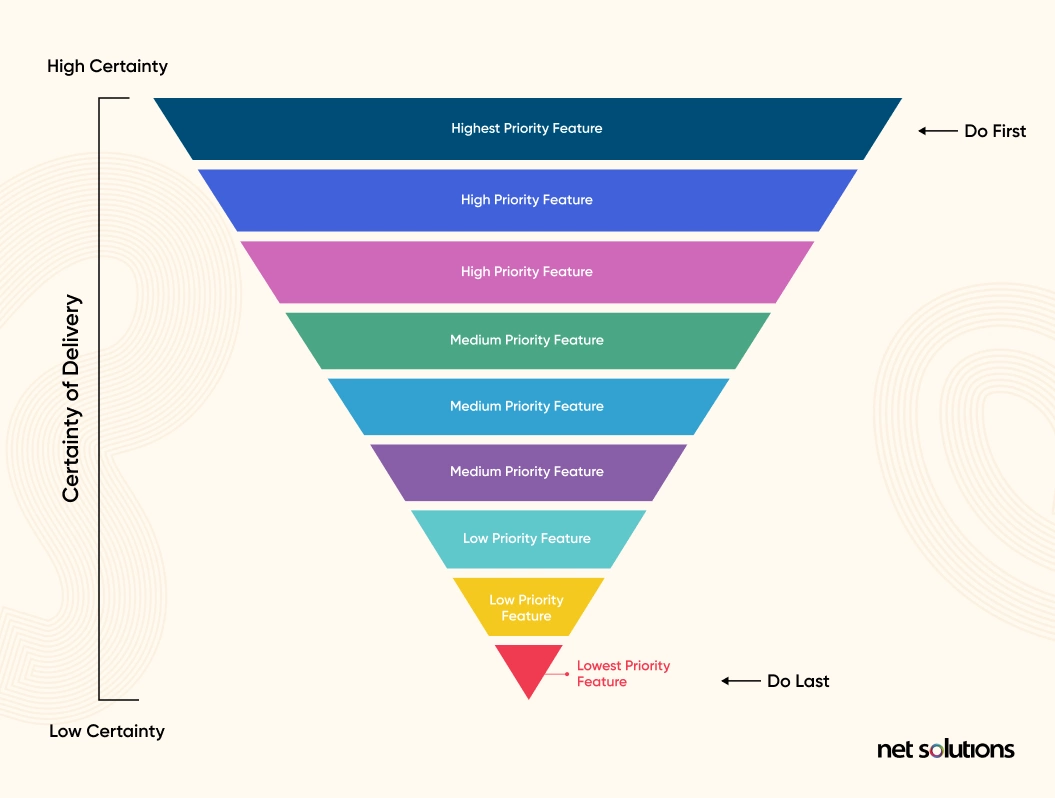
12. Missing agile retrospective
The Agile retrospective is a great chance to reflect on a scrum and analyze what went great and what could be better. However, in some organizations, scrum masters never schedule a retrospective because they feel it’s not essential. It turns out to be a critical agile mistake as they miss out on critical learnings that could save them hours of effort later on.
Agile retrospectives are a crucial part of our software development process. At the end of each sprint, we hold a meeting to reflect on our achievements, failures, and what we can improve. Then, we document and use these learnings to improve our software development process in the future.
Frequently Asked Questions
You can know whether your agile initiative is heading on the right path or not with the following signs:
- You deliver your sprints on time.
- Product quality only gets better with each product release.
- Customers have positive feedback on your product.
- You provide significant business value with each sprint.
- The progress of your project is visible to all the stakeholders.
No, Agile only works for large products with unclear specifications. Using other software development approaches like the waterfall model is better for small projects with clear goals and enough time.
Zero sprints refer to all the activities before the first sprint formally kicks off. The idea is to have all the development team members come together to develop a minimal number of User Stories, project skeleton, story mapping, and create a workable product.
- Establish flow
- Peer review and pairing
- Collective ownership and standards
- Automation
- Definition of done





